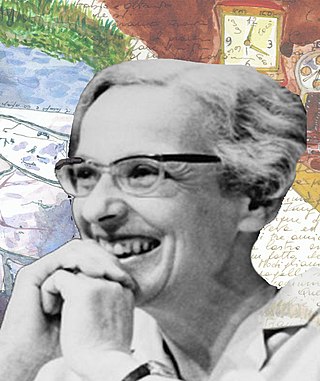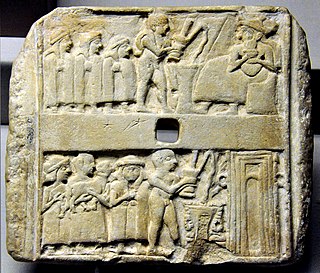Related Research Articles

Inanna is the ancient Mesopotamian goddess of love, war, and fertility. She is also associated with beauty, sex, divine law, and political power. Originally worshiped in Sumer, she was known by the Akkadian Empire, Babylonians, and Assyrians as Ishtar. Her primary title was "the Queen of Heaven".

A dying-and-rising, death-rebirth, or resurrection deity is a religious motif in which a god or goddess dies and is resurrected. Examples of gods who die and later return to life are most often cited from the religions of the ancient Near East. The traditions influenced by them include the Greco-Roman mythology. The concept of a dying-and-rising god was first proposed in comparative mythology by James Frazer's seminal The Golden Bough (1890). Frazer associated the motif with fertility rites surrounding the yearly cycle of vegetation. Frazer cited the examples of Osiris, Tammuz, Adonis and Attis, Zagreus, Dionysus, and Jesus.

Scapegoating is the practice of singling out a person or group for unmerited blame and consequent negative treatment. Scapegoating may be conducted by individuals against individuals, individuals against groups, groups against individuals, and groups against groups.

In Mesopotamian mythology, Ereshkigal was the goddess of Kur, the land of the dead or underworld in Sumerian mythology. In later myths, she was said to rule Irkalla alongside her husband Nergal. Sometimes her name is given as Irkalla, similar to the way the name Hades was used in Greek mythology for both the underworld and its ruler, and sometimes it is given as Ninkigal, lit. "Lady of the Great Earth".
Namtar was a figure in ancient Mesopotamian religion who, depending on the context, could be regarded both as a minor god and as a demon of disease. He is best attested as the sukkal of Ereshkigal, the goddess of the underworld. Like her, he was not the object of active worship, though references to it are made in literary texts, and additionally some incantations entrust him with keeping various other malevolent forces in the underworld.

Marion Jean Woodman was a Canadian mythopoetic author, poet, analytical psychologist and women's movement figure. She wrote and spoke extensively about the dream theories of Carl Jung. Her works include Addiction to Perfection, The Pregnant Virgin and Bone: Dying into Life.

Analytical psychology is a term coined by Carl Jung, a Swiss psychiatrist, to describe research into his new "empirical science" of the psyche. It was designed to distinguish it from Freud's psychoanalytic theories as their seven-year collaboration on psychoanalysis was drawing to an end between 1912 and 1913. The evolution of his science is contained in his monumental opus, the Collected Works, written over sixty years of his lifetime.
The Triple Goddess is a deity or deity archetype revered in many Neopagan religious and spiritual traditions. In common Neopagan usage, the Triple Goddess is viewed as a triunity of three distinct aspects or figures united in one being. These three figures are often described as the Maiden, the Mother, and the Crone, each of which symbolizes both a separate stage in the female life cycle and a phase of the Moon, and often rules one of the realms of heavens, earth, and underworld. In various forms of Wicca, her masculine consort is the Horned God.

Marie-Louise von Franz was a Swiss Jungian psychologist and scholar, known for her psychological interpretations of fairy tales and of alchemical manuscripts.

The Dance of the Seven Veils is Salome's dance performed before King Herod Antipas, in modern stage, literature and visual arts. It is an elaboration on the New Testament story of the Feast of Herod and the execution of John the Baptist, which refers to Salome dancing before the king, but does not give the dance a name.
Archetypal psychology was initiated as a distinct movement in the early 1970s by James Hillman, a psychologist who trained in analytical psychology and became the first Director of the Jung Institute in Zurich. Hillman reports that archetypal psychology emerged partly from the Jungian tradition whilst drawing also from other traditions and authorities such as Henry Corbin, Giambattista Vico, and Plotinus.
Archetypal literary criticism is a type of analytical theory that interprets a text by focusing on recurring myths and archetypes in the narrative, symbols, images, and character types in literary works. As an acknowledged form of literary criticism, it dates back to 1934 when Classical scholar Maud Bodkin published Archetypal Patterns in Poetry.
The Jungian interpretation of religion, pioneered by Carl Jung and advanced by his followers, is an attempt to interpret religion in the light of Jungian psychology. Unlike Sigmund Freud and his followers, Jungians tend to treat religious beliefs and behaviors in a positive light, while offering psychological referents to traditional religious terms such as "soul", "evil", "transcendence", "the sacred", and "God". Because beliefs do not have to be facts in order for people to hold them, the Jungian interpretation of religion has been, and continues to be, of interest to psychologists and theists.
In Sumerian religion, Gugalanna is the first husband of Ereshkigal, the queen of the underworld. His name probably originally meant "canal inspector of An" and he may be merely an alternative name for Ennugi. The son of Ereshkigal and Gugalanna is Ninazu. In Inanna's Descent into the Underworld, Inanna, the goddess of love, beauty, sex, and war, tells the gatekeeper Neti that she is descending to the Underworld to attend the funeral of "Gugalanna, the husband of my elder sister Ereshkigal". Some scholars consider Gugalanna to be the same figure as the Bull of Heaven, slain by Gilgamesh and Enkidu in the Epic of Gilgamesh.

Sumerian religion was the religion practiced by the people of Sumer, the first literate civilization of ancient Mesopotamia. The Sumerians regarded their divinities as responsible for all matters pertaining to the natural and social orders.
Barbara Hannah was born in England. She is well known for her association with Carl Gustav Jung whom she joined in 1929 in Zurich and remained so until his death.

The Origins and History of Consciousness is a 1949 book by the psychologist and philosopher Erich Neumann, in which the author attempts to "outline the archetypal stages in the development of consciousness". It was first published in English in 1954 in a translation by R. F. C. Hull. The work has been seen as an important and enduring contribution to Jungian thought.

The Great Mother: An Analysis of the Archetype is a book discussing mother goddesses by the psychologist Erich Neumann. The dedication reads, "To C. G. Jung friend and master in his eightieth year". Although Neumann completed the German manuscript in Israel in 1951, The Great Mother was first published in English in 1955. The work has been seen as an enduring contribution to the literature inspired by Jung, and was the first to analyze an archetype with such depth and scope.

The ancient Mesopotamian underworld, most often known in Sumerian as Kur, Irkalla, Kukku, Arali, or Kigal and in Akkadian as Erṣetu, although it had many names in both languages, was a dark, dreary cavern located deep below the ground, where inhabitants were believed to continue "a transpositional version of life on earth". The only food or drink was dry dust, but family members of the deceased would pour sacred mineral libations from the earth for them to drink. In the Sumerian underworld, it was initially believed that there was no final judgement of the deceased and the dead were neither punished nor rewarded for their deeds in life.

Scholars, including psychoanalysts, have commented that J. R. R. Tolkien's Middle-earth stories about both Bilbo Baggins, protagonist of The Hobbit, and Frodo Baggins, protagonist of The Lord of the Rings, constitute psychological journeys. Bilbo returns from his journey to help recover the Dwarves' treasure from Smaug the dragon's lair in the Lonely Mountain changed, but wiser and more experienced. Frodo returns from his journey to destroy the One Ring in the fires of Mount Doom scarred by multiple weapons, and is unable to settle back into the normal life of his home, the Shire.
References
- 1 2 Crowley, Vivianna (2017). "Perera, Sylvia Brinton". In Leeming, David A. (ed.). Encyclopedia of Psychology and Religion. Berlin and Heidelberg: Springer. pp. 1–4. doi:10.1007/978-3-642-27771-9_200092-1. ISBN 978-3-642-27771-9.
- ↑ "Mother Earth Body Self. Therapeutic Process as Return and (Re-)Emergence". Jungianthology (Podcast). C. G. Jung Institute of Chicago. November 24, 2014. Retrieved October 17, 2018.
- ↑ Goode, Erica (September 27, 1998). "Edward Whitmont, 85, Leader in teaching Jungian psychology". The New York Times . Retrieved October 16, 2018.
- ↑ Samuels, Andrew (1985). Jung and the Post-Jungians. London: Routledge and Kegan Paul. pp. 217–219.
- ↑ Whitmont, Edward C. (1992) [1984]. Return of the Goddess. New York: Crossroad Publishing. pp. 133–135.
- ↑ Neumann, Erich (1954). "On the Moon and Matriarchal Consciousness". Spring : 64–118.
- ↑ Rowland, Susan (2001). Jung. A Feminist Revision. Cambridge: Polity Press (Blackwell). pp. 62–63.